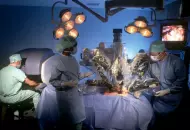MRI Guidance Before Prostate Surgery
An advanced MRI mapping from the Sperling Prostate Center can help inform all three surgical approaches to prostate cancer treatment: open prostatectomy, laparoscopy prostatectomy, or robot-assisted laparoscopic prostatectomy. The use of MRI imaging can be invaluable in helping to evaluate the location, extent, volume and aggressiveness of the cancer. Likewise, MRI imaging has been shown to have an incremental value in treatment planning over just the use of predictive models (nomograms) by themselves. Furthermore, anatomic and metabolic prostate mapping offers a greater possibility of optimizing treatment planning and thus further expanding the role of patient-specific, individualized treatment.
More specifically, MRI mapping allows physicians to assess the extent and location of disease and thereby improve local staging. That means your doctor can be more certain if the cancer is truly localized within the prostate or if the cancer may have spread outside the gland or invaded the seminal vesicles. Naturally, this is vital information that can provide surgeons with a visual map for treatment planning.
Additionally, an MRI before prostate surgery can contribute indirectly to a decision to preserve of one or both neurovascular bundles that control a man’s erectile function. The location, extent and aggressiveness of prostate tumors will determine whether a patient is a candidate for nerve sparing radical prostatectomy. Published studies have demonstrated that pre-surgical MRI diagnostics correlate well with the actual lesions when the post-surgically removed glands are analyzed. However, the experience level of the radiologist who reads the MRI images will make a difference, as more experience leads to greater accuracy.1
 Consider these findings: A study performed at the University of California, Los Angeles, was presented before the 2010 Annual Meeting of the American Roentgen Ray Society (ARRS) by lead author Timothy McClure, MD. According to Dr. McClure, “Twenty-nine out of 104 patients had the nerve sparing technique changed because of MR imaging. Of patients for whom the plan was changed, 49 percent underwent nerve sparing surgery and 40 percent had their plan changed to non-nerve sparing surgery.”
Consider these findings: A study performed at the University of California, Los Angeles, was presented before the 2010 Annual Meeting of the American Roentgen Ray Society (ARRS) by lead author Timothy McClure, MD. According to Dr. McClure, “Twenty-nine out of 104 patients had the nerve sparing technique changed because of MR imaging. Of patients for whom the plan was changed, 49 percent underwent nerve sparing surgery and 40 percent had their plan changed to non-nerve sparing surgery.”
Advantages of MRI Mapping Before Prostate Surgery
The Sperling Prostate Center team unites advanced technology with experience, providing superior MRI mapping to shed light on surgical treatment decisions.
- Accurate tumor location and extent
- Greater detail than available with Ultrasound alone
- Supplements biopsy information
- Collaboration with Urologist
Who Should Consider MRI Mapping Prior to Surgery
- Patients planning to have a nerve sparing radical prostatectomy may benefit from MRI confirmation of their eligibility
- Patients desiring nerve-sparing prostatectomy but whose current diagnostics (including Ultrasound imaging, biopsy and pathology) is not conclusive.
- Patients and/or physicians desiring a visual prostate map to better determine treatment planning.
- Patients who have a high-risk and/or high volume tumors and therefore who’s surgeon is concerned about cancer outside the prostate gland.
- Djavan B et al. Prospective evaluation of prostate cancer detected on biopsies 1, 2, 3, and 4: w. J Urol . 166. 1979-83. (2001).

